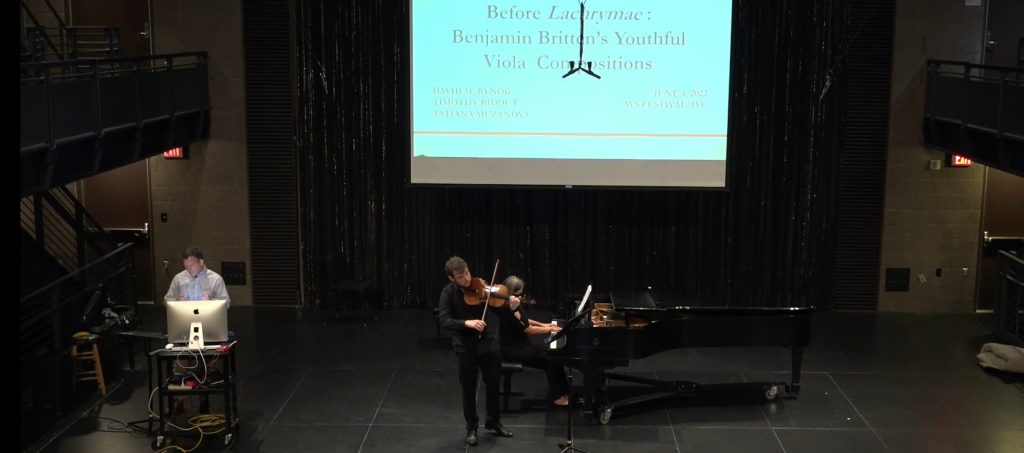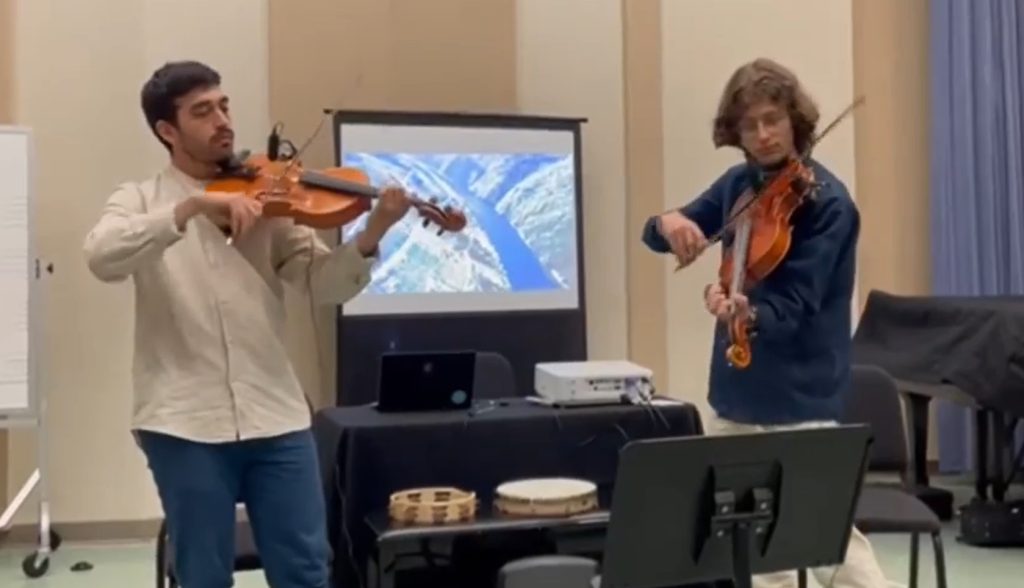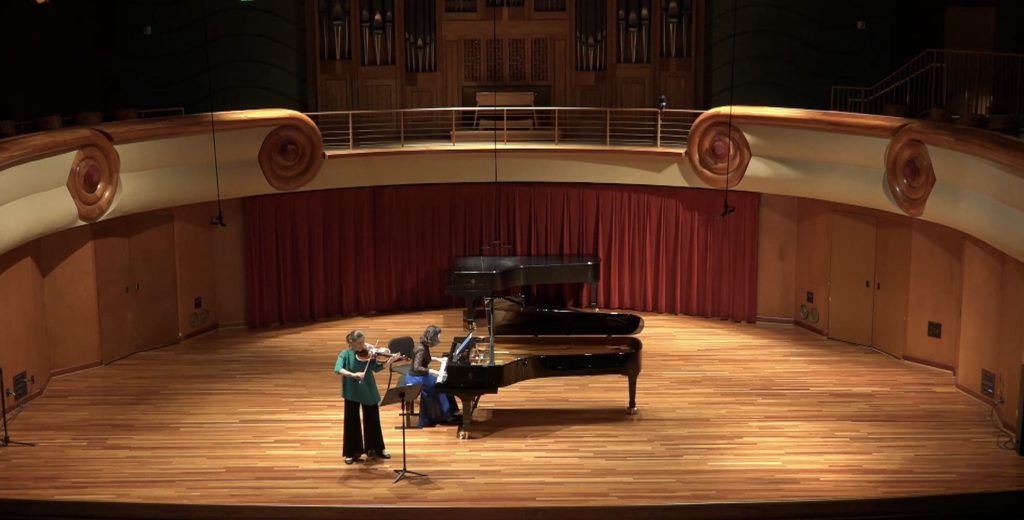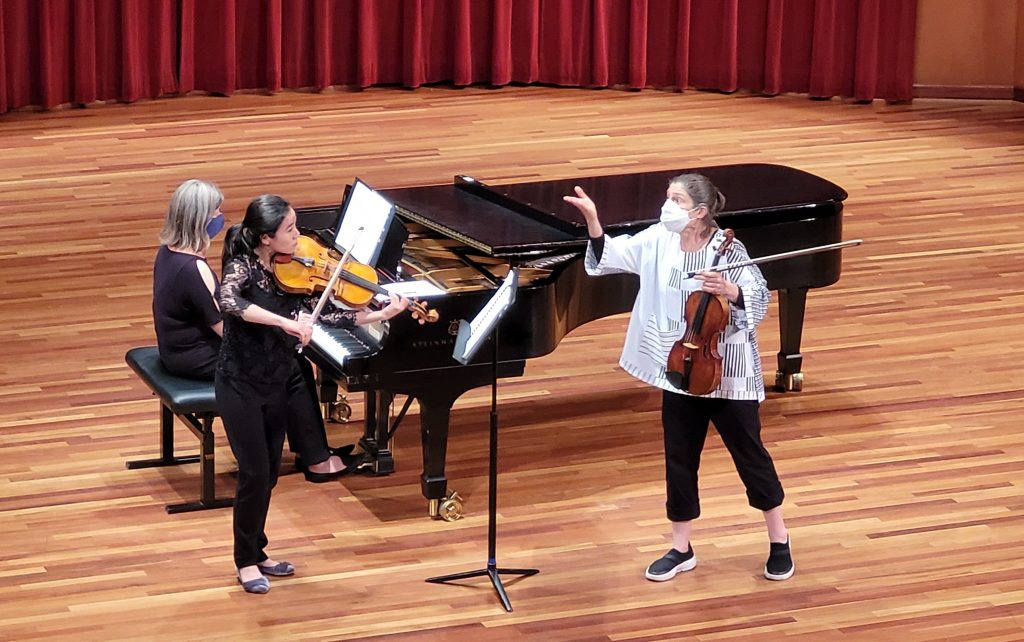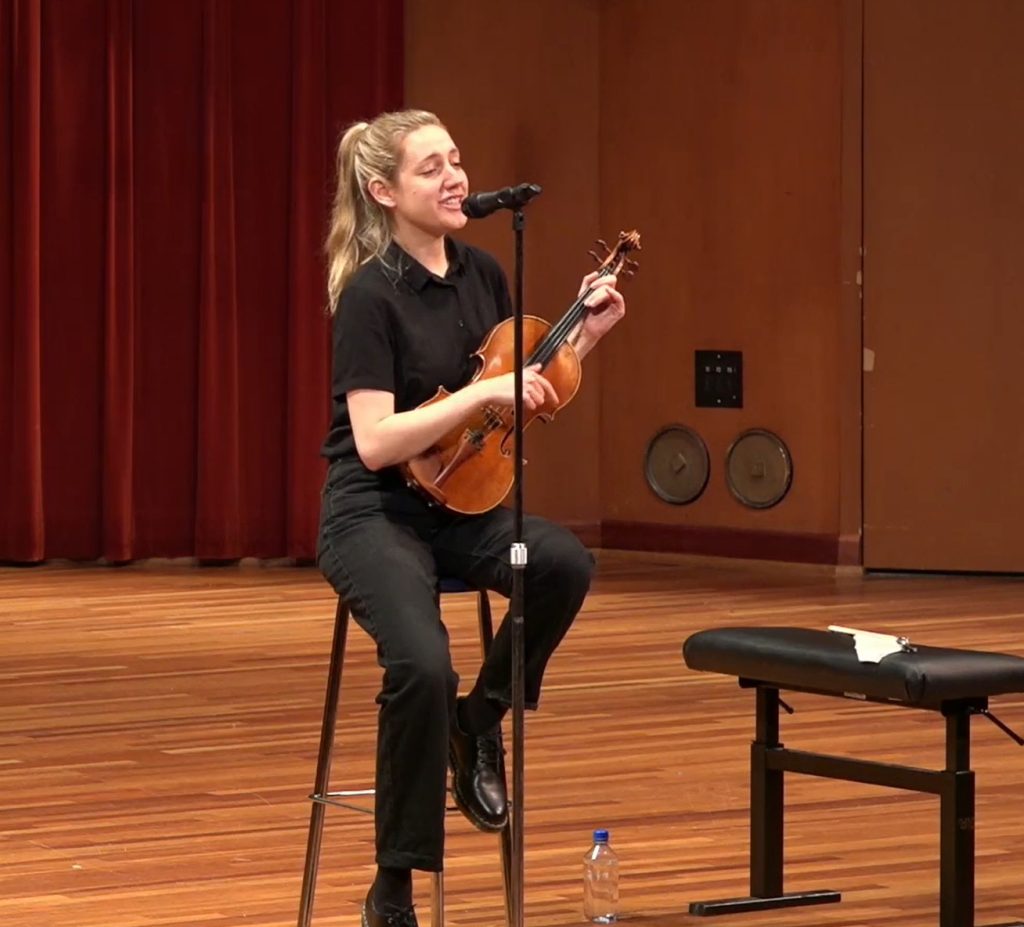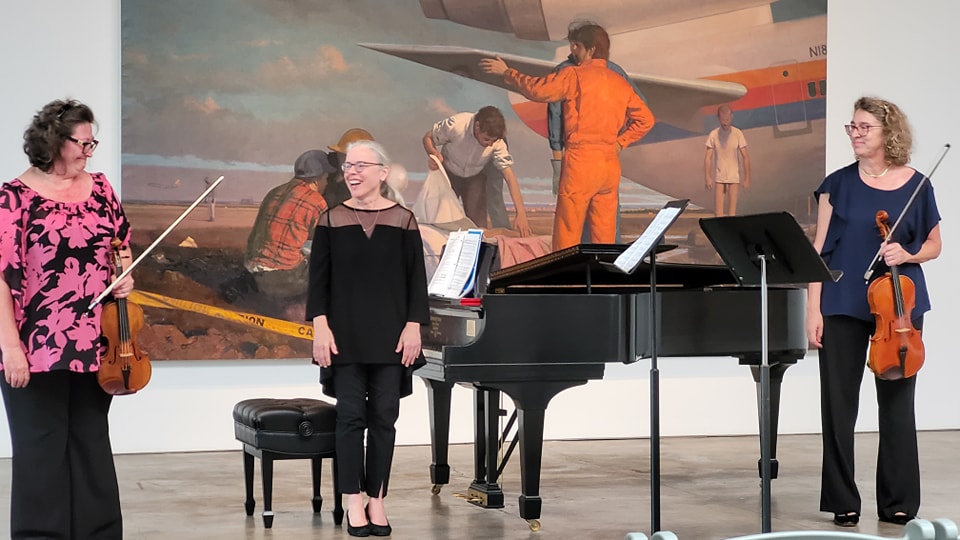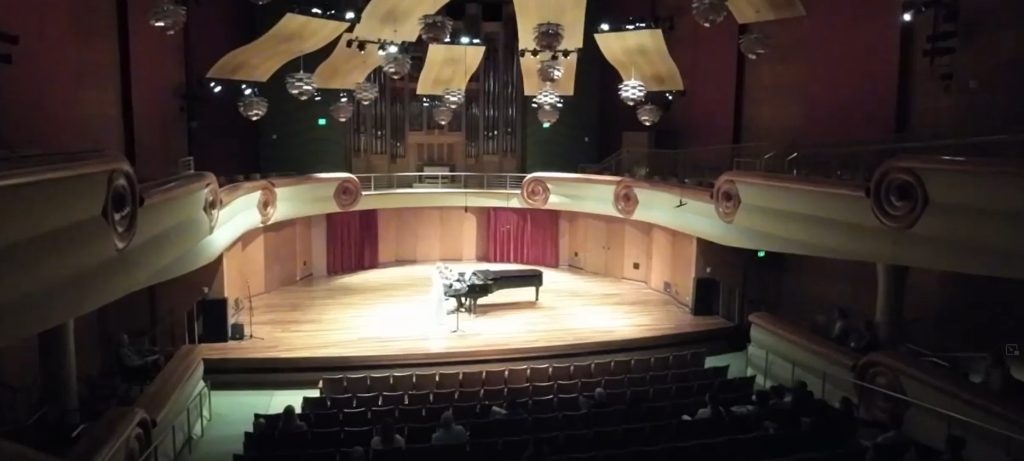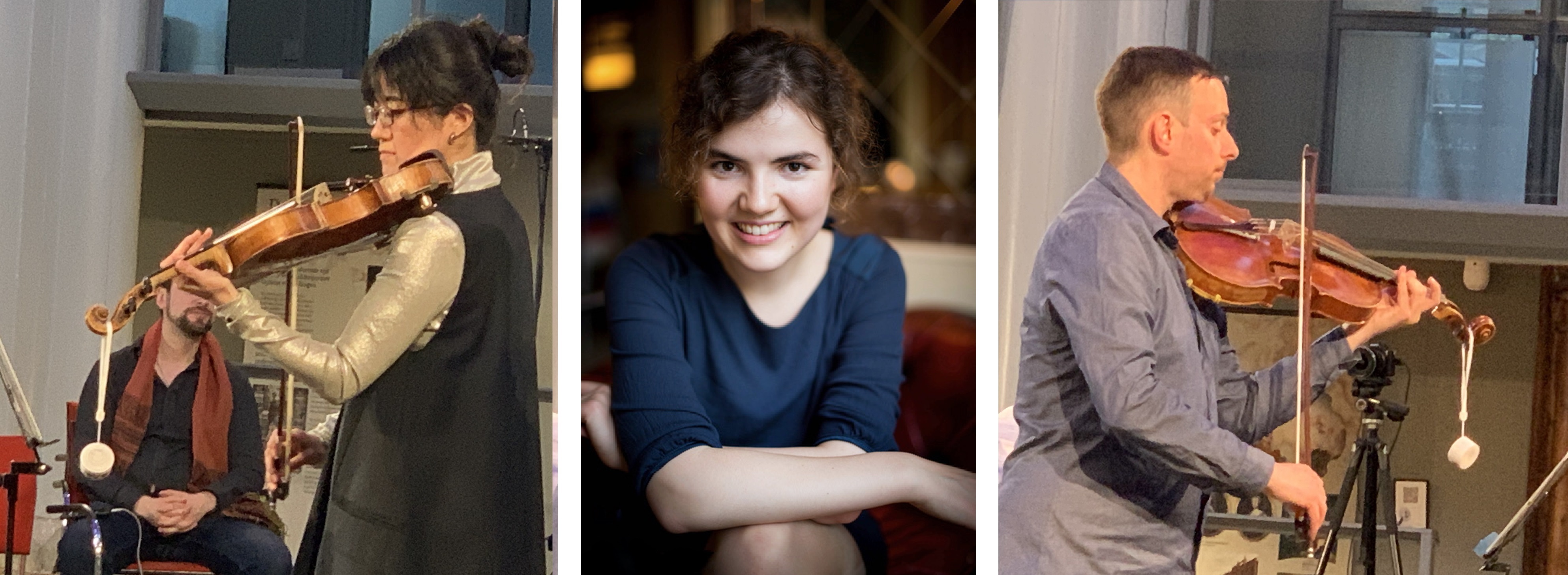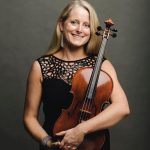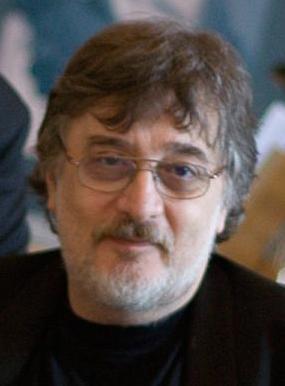Van 14 t/m 20 oktober vindt in München het 1e Internationale Hindemith-concours plaats. Onze verslaggeefster ter plaatse is Karin Dolman, en ze geeft op haar unieke wijze met tekst en eigen tekeningen impressies van het concours door.
Op 15 oktober luisteren we met een handvol publiek en de jury naar 17 kandidaten die zijn geslecteerd uit een ingestuurde video. 102 kandidaten hadden zich aangemeld, en
uit deze groep zijn 20 kandidaten geselecteerd. Drie geselecteerde kandidaten zijn niet gekomen om welke reden dan ook. Wat we te horen krijgen in de Concertzaal van het Conservatorium in München is de crème de la crème van jonge altviolisten.
 Al meteen met de eerste kandidate Katie Liu wordt de toon gezet. Ze speelt uit de 6e suite van Bach de Prelude en de Allemande. De nieuwe technologie komt ook het podium op. De tablet met voetpedaal! Prachtige toon! Met een zeer vast tempo, en goed volgehouden ook in de snelle slierten. Met een adempauze na de akkoorden. De Allemande mooi van toon. De Form und Zetmaß einer Passaglia opus 11/5 van Hindemith is één van de verplichte stukken. Of men kon het laatste deel uit de 31/4 kiezen. Katie koos voor de eerste. En dat doet ze heel knap.
Al meteen met de eerste kandidate Katie Liu wordt de toon gezet. Ze speelt uit de 6e suite van Bach de Prelude en de Allemande. De nieuwe technologie komt ook het podium op. De tablet met voetpedaal! Prachtige toon! Met een zeer vast tempo, en goed volgehouden ook in de snelle slierten. Met een adempauze na de akkoorden. De Allemande mooi van toon. De Form und Zetmaß einer Passaglia opus 11/5 van Hindemith is één van de verplichte stukken. Of men kon het laatste deel uit de 31/4 kiezen. Katie koos voor de eerste. En dat doet ze heel knap.
Atar Arad heeft de opdracht gekregen om voor dit concours het opdrachtwerk te schrijven. Net als Hindemith schrijft hij voor het instrument, maakt gebruik van de kwinten van het instrument en van alle effecten die de altviool zo altviool maken, zonder haar virtuositeit te laten. Het is een Chaconne geworden! Ik hoor het vandaag voor het eerst. Petje af voor alle kandidaten, die dit prachtige maar o zo moeilijke stuk hebben ingestudeerd. Ik verheug me om het wel 17 keer te mogen horen.
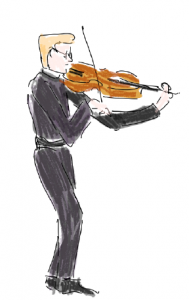 Ionel Ungureanu speelt uit de Bach-suite nummer 4 de Prelude en Bourree 1 en 2. Na een wat onzeker begin duikt hij met veel energie in Arad’s Chaconne en geeft ons een waanzinnig pallet aan kleuren. En de Hindemith 31/4 uit het hoofd – en geloof me, zelfs Hindemith had moeite om deze sonate goed te spelen.
Ionel Ungureanu speelt uit de Bach-suite nummer 4 de Prelude en Bourree 1 en 2. Na een wat onzeker begin duikt hij met veel energie in Arad’s Chaconne en geeft ons een waanzinnig pallet aan kleuren. En de Hindemith 31/4 uit het hoofd – en geloof me, zelfs Hindemith had moeite om deze sonate goed te spelen.
 Als derde komt Takehiro Konoye, een bekende voor ons van het Conservatorium van Amsterdam. Bach-Suite nummer 2 op het programma. Loepzuiver en met gemak gaat hij zijn altviool te lijf. De Chaconne van Arad heeft weer een ander palet van kleuren, o wat een fijn stuk. De Hindemith gaat uit het hoofd, en meteen is daar een betere performer. Lessenaar ook goed weg gezet. Mooi getimed. Geweldig gespeeld. Met rust en gevoel.
Als derde komt Takehiro Konoye, een bekende voor ons van het Conservatorium van Amsterdam. Bach-Suite nummer 2 op het programma. Loepzuiver en met gemak gaat hij zijn altviool te lijf. De Chaconne van Arad heeft weer een ander palet van kleuren, o wat een fijn stuk. De Hindemith gaat uit het hoofd, en meteen is daar een betere performer. Lessenaar ook goed weg gezet. Mooi getimed. Geweldig gespeeld. Met rust en gevoel.
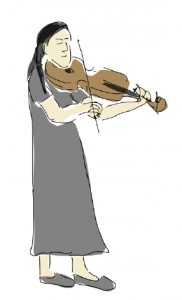 Yuri Yoon speelt uit Bach-suite nummer 2 de Prelude en Gigue, met barokstok. Hindemith heel goed gespeeld, helaas net een paar teveel foutjes. En het tempo is wel erg bedeesd. Arad: kleuren zijn er wel, maar iets te snel achter elkaar.
Yuri Yoon speelt uit Bach-suite nummer 2 de Prelude en Gigue, met barokstok. Hindemith heel goed gespeeld, helaas net een paar teveel foutjes. En het tempo is wel erg bedeesd. Arad: kleuren zijn er wel, maar iets te snel achter elkaar.
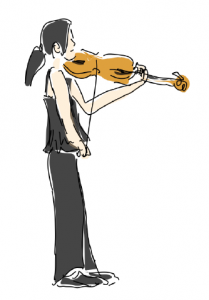 Gaeun Song begint heel verrassend met de verplichte Chaconne. Een heel romantische uitvoering, gepassioneerd. Daarna de Passacaglia van Hindemith. Ook een mooie gepassioneerde uitvoering. Toch niet zo verrassend want we krijgen de Bach vijfde suite in scordatura. Moeilijk blijft het om er een eigen verhaal van te maken. Wanneer je met iets heel intiems overblijft kan het nog intiemer gespeeld worden .
Gaeun Song begint heel verrassend met de verplichte Chaconne. Een heel romantische uitvoering, gepassioneerd. Daarna de Passacaglia van Hindemith. Ook een mooie gepassioneerde uitvoering. Toch niet zo verrassend want we krijgen de Bach vijfde suite in scordatura. Moeilijk blijft het om er een eigen verhaal van te maken. Wanneer je met iets heel intiems overblijft kan het nog intiemer gespeeld worden .
 Erin Pitts – op blote voeten, ja waarom niet. Bach suite 4 Prelude en Sarabande met leuke versieringen. Lekker speels. Misschien niet 100 % zuiver, maar heel interessant en fijn om naar te luisteren. En een hele krachtige Hindemith. Een vrouw met pit, ha ha, het zit in de naam. Ze is duidelijk op het podium. Met grote extremen in dynamiek speelt de Chaconne van Arad. Misschien nog niet helemaal klaar met studeren op het stuk, maar voor mij een duidelijk verhaal.
Erin Pitts – op blote voeten, ja waarom niet. Bach suite 4 Prelude en Sarabande met leuke versieringen. Lekker speels. Misschien niet 100 % zuiver, maar heel interessant en fijn om naar te luisteren. En een hele krachtige Hindemith. Een vrouw met pit, ha ha, het zit in de naam. Ze is duidelijk op het podium. Met grote extremen in dynamiek speelt de Chaconne van Arad. Misschien nog niet helemaal klaar met studeren op het stuk, maar voor mij een duidelijk verhaal.
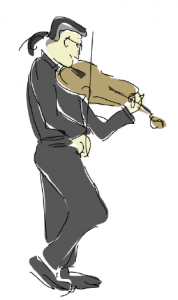 Wenhan Jiang gaat aan de slag met Bach Suite 2. Wanneer Wenhan zou zeggen dat hij een groot fan is van Nigel Kennedy, zou ik het meteen geloven. Modern kapsel en een zeer persoonlijke manier van spelen. Ook hij komt met een versierd einde in de prelude. En wel een zeeeeeer versierd einde. Ook de twee menuetten zijn rijkversierd, maar nergens dat ik ergens van op kijk. Het stuk van Arad speelt hij geweldig, rijk gevuld met allerlei klanken. Hij idd de enige die Atar bedankt voor de mooie Chaconne! De Hindemith is ongelofelijk goed. Foutloos en, nou gewoon om jaloers van te worden. Behalve zijn nek, wanneer hij later geen klachten krijgt dan eet ik mijn schoen op.
Wenhan Jiang gaat aan de slag met Bach Suite 2. Wanneer Wenhan zou zeggen dat hij een groot fan is van Nigel Kennedy, zou ik het meteen geloven. Modern kapsel en een zeer persoonlijke manier van spelen. Ook hij komt met een versierd einde in de prelude. En wel een zeeeeeer versierd einde. Ook de twee menuetten zijn rijkversierd, maar nergens dat ik ergens van op kijk. Het stuk van Arad speelt hij geweldig, rijk gevuld met allerlei klanken. Hij idd de enige die Atar bedankt voor de mooie Chaconne! De Hindemith is ongelofelijk goed. Foutloos en, nou gewoon om jaloers van te worden. Behalve zijn nek, wanneer hij later geen klachten krijgt dan eet ik mijn schoen op.
 Seohyun Moon speelt uit de vierde Bach-suite Courante en Sarabande. Ik merk dat verwend wordt met al die mooie klanken. Heel uitgebalanceerd. Het stuk van Arad gaat nooit vervelen. Iedere keer haalt wel weer een andere kandidaat iets anders moois naar voren. Deze jongeman is vooral goed om in de dubbelgrepen de juiste stem in zijn hele volheid naar voren te brengen. Deze Seohyun presteert het om met CD kwaliteit te spelen. Waar anderen hun podiumpresentatie ook nog in het spel moeten zetten kan hij iedere noot de juiste perfectie geven, en ook een mooie vibrato non vibrato en niet saai!
Seohyun Moon speelt uit de vierde Bach-suite Courante en Sarabande. Ik merk dat verwend wordt met al die mooie klanken. Heel uitgebalanceerd. Het stuk van Arad gaat nooit vervelen. Iedere keer haalt wel weer een andere kandidaat iets anders moois naar voren. Deze jongeman is vooral goed om in de dubbelgrepen de juiste stem in zijn hele volheid naar voren te brengen. Deze Seohyun presteert het om met CD kwaliteit te spelen. Waar anderen hun podiumpresentatie ook nog in het spel moeten zetten kan hij iedere noot de juiste perfectie geven, en ook een mooie vibrato non vibrato en niet saai!
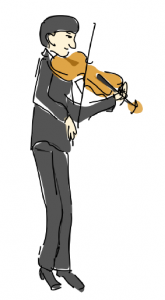 Dong Yeob Kong opent met de zesde suite van Bach. Daarna Atar Arad’s Chaconne. En weer horen we nieuwe inzichten. Passacaglia van Hindemith: Wat een prachtige akkoorden. Je kunt zo mooi de bas volgen!
Dong Yeob Kong opent met de zesde suite van Bach. Daarna Atar Arad’s Chaconne. En weer horen we nieuwe inzichten. Passacaglia van Hindemith: Wat een prachtige akkoorden. Je kunt zo mooi de bas volgen!
Ja ja, maar dan is onze dag nog niet klaar. Want wij moeten nog naar de opening van een tentoonstelling over Hindemith en Walter Witte. Deze tentoonstelling over twee mensen die in een roerige tijd leefden was uitgerekend in het bureau van Adolf Hitler. Een zelfs geëmotioneerde voorzitter, Ludwig Hampe ook altviolist, van de Witte Stichting, die het Hindemith-concours financieert, gaf een zeer goede lezing over Hindemith en Walter Witte. En ook de zaal werd in het verhaal betrokken. Indrukwekkend.
Jutta Puchhammer, voorzitter van de IVS met wie ik een kamer deel, en ik zijn even naar ons hotel terug gegaan. Hebben een eitje gebakken en omkleden en dan weer terug voor het “Meisterkonzert”. Danusha Waskiewiecz speelt met pianiste Yumi Sekiya. Eerst allemaal bewerkingen van zangstukken. Vooral het stukje van Sibelius “Norden” vond ik erg mooi. En er volgt een mooie maar hele snelle Rebecca Clarke sonate. Na de sonate komt Waskiewiecz terug met Naomi Berrill op cello. Dat was een mooie verrassing, want ze konden ook nog eens alle twee mooi zingen tegelijkertijd. Prachtig. Met werken van Dowland, Purcell Wolf, Bach en Bartók.
Dan na een korte pauze treedt op het podium de Noor Lars Anders Tomter. Hij is gewoon zichzelf en speelt ook als zichzelf, geen poespas, geen dansjes, maar doet gewoon zijn ding. Ook weer prachtig. We worden wel verwend. Eerst de Brahms Sonate is Es en als tweede en laatste stuk van de avond Schostakowitsch sonate opgedragen aan Vladimir Mendelssohn.
Eerste Ronde – Dag 2, 16 oktober:
 Alona Khievna: Wat is dit Ukraine meisje goed! Ten eerste alles uit het hoofd, Alles ziet er ook zo natuurlijk uit. geweldige stokvoering en een prachtig verhaal. Een rijke vibrato en durft in de extremen te gaan. Een absolute favoriet voor mij. En zij doet het op een niet de allermooiste altviool. Op het programma de eerste partita (nr2) en Hindemith 11/5.
Alona Khievna: Wat is dit Ukraine meisje goed! Ten eerste alles uit het hoofd, Alles ziet er ook zo natuurlijk uit. geweldige stokvoering en een prachtig verhaal. Een rijke vibrato en durft in de extremen te gaan. Een absolute favoriet voor mij. En zij doet het op een niet de allermooiste altviool. Op het programma de eerste partita (nr2) en Hindemith 11/5.
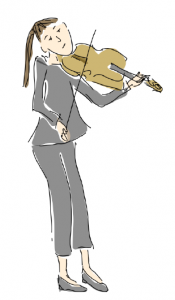 Dan komt de jongste het podium op: Carla Usberti, een Duits meisje. Weer zo goed, prachtige toon. En alles uit het hoofd. En pas 20 jaar!. Te bedenken dat zo’n meisje nog aan haar studie kan gaan beginnen. Op het programma Bach Suite 3 en Hindemith 11/5.
Dan komt de jongste het podium op: Carla Usberti, een Duits meisje. Weer zo goed, prachtige toon. En alles uit het hoofd. En pas 20 jaar!. Te bedenken dat zo’n meisje nog aan haar studie kan gaan beginnen. Op het programma Bach Suite 3 en Hindemith 11/5.
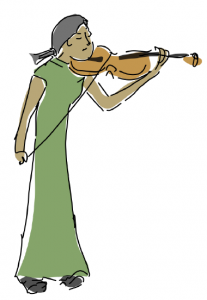 Emiko Yuasa studeert ook in München. Op het programma Bach suite 2 en Hindemith 31/4. Weer een kandidaat voor de volgende ronde. Ik weet gewoon niet meer welke kandidaten er voor een volgende ronde in aanmerking komen.
Emiko Yuasa studeert ook in München. Op het programma Bach suite 2 en Hindemith 31/4. Weer een kandidaat voor de volgende ronde. Ik weet gewoon niet meer welke kandidaten er voor een volgende ronde in aanmerking komen.
 Annariina Jokela uit Finland. op het programma Bach-suite nr 4 en Hindemith 31/4. Ze begint met het stuk van Arad. Inmiddels kan ik de partij meelezen, wat weer een heleboel inzichten geeft. Het stuk heeft zeker een Jiddisch karakter. Ook pizzicato wordt als ondersteuning, maar ook als melodisch motief gebruikt. In zijn caprices is een overeenkomst met de anonymus. Alweer een geweldige uitvoering van Annariina. Helaas raakt ze in de in de Bach even het spoor bijster en moet de muziek erbij pakken. Je hoort bij haar heel goed de verschillende variaties. Speelt ook een ietwat rustiger tempo.
Annariina Jokela uit Finland. op het programma Bach-suite nr 4 en Hindemith 31/4. Ze begint met het stuk van Arad. Inmiddels kan ik de partij meelezen, wat weer een heleboel inzichten geeft. Het stuk heeft zeker een Jiddisch karakter. Ook pizzicato wordt als ondersteuning, maar ook als melodisch motief gebruikt. In zijn caprices is een overeenkomst met de anonymus. Alweer een geweldige uitvoering van Annariina. Helaas raakt ze in de in de Bach even het spoor bijster en moet de muziek erbij pakken. Je hoort bij haar heel goed de verschillende variaties. Speelt ook een ietwat rustiger tempo.
 Hung-Tzu Chu uit Taiwan heeft op het programma Bach suite nr 2 en Hindemith 11/5. Ze speelt met veel pit, heeft af en toe wat intonatieproblemen, maar compenseert dit met haar muzikale lijnen. Ik besef dat in de stukken de vibrato weinig kans krijgt om te zingen, maar die momenten die er zijn kunnen eigenlijk bij bijna alle kandidaten niet iets worden benut. Ze sluit af met een vurige Hindemith.
Hung-Tzu Chu uit Taiwan heeft op het programma Bach suite nr 2 en Hindemith 11/5. Ze speelt met veel pit, heeft af en toe wat intonatieproblemen, maar compenseert dit met haar muzikale lijnen. Ik besef dat in de stukken de vibrato weinig kans krijgt om te zingen, maar die momenten die er zijn kunnen eigenlijk bij bijna alle kandidaten niet iets worden benut. Ze sluit af met een vurige Hindemith.
 Je zegt nu bijna, eindelijk weer een man! wanneer de zeer jonge Noor Njord Kårason Fossnes op het podium komt. Op het programma Bach suite 2, met barokstok. Die ziet wel erg kort uit. Maar dat komt waarschijnlijk omdat een reus op het podium staat. En weer een kandidaat die alles uit zijn hoofd doet. Wat een geweldenaar. Misschien in de echt de snelste passages laten zijn vingers niet de echte nauwkeurigheid zien. Maar zeker eenkandidaat voor de volgende ronde.
Je zegt nu bijna, eindelijk weer een man! wanneer de zeer jonge Noor Njord Kårason Fossnes op het podium komt. Op het programma Bach suite 2, met barokstok. Die ziet wel erg kort uit. Maar dat komt waarschijnlijk omdat een reus op het podium staat. En weer een kandidaat die alles uit zijn hoofd doet. Wat een geweldenaar. Misschien in de echt de snelste passages laten zijn vingers niet de echte nauwkeurigheid zien. Maar zeker eenkandidaat voor de volgende ronde.
 Oscar Edin uit Zweden heeft op het programma (viool-)Partita nr.2 van Bach en Hindemith 11/5. Wat een mooie toon en gevoel voor een heel nuchtere Bach. Ik hoop dat het ene foutje wordt kwijt gescholden. Hij steekt helemaal voorop het podium, wat maakt dat je het gevoel hebt samen met hem muziek te maken. Zijn afkorten zijn ook heel mooi rustig en je hoort mooi alle noten. nog 2 keer de Chaconne. Mooie toon, maar hij kon nog wat gedurfder spelen. Specialiteit misschien de tijdgenoten? Heel goed, dat stuk van Atar Arad.
Oscar Edin uit Zweden heeft op het programma (viool-)Partita nr.2 van Bach en Hindemith 11/5. Wat een mooie toon en gevoel voor een heel nuchtere Bach. Ik hoop dat het ene foutje wordt kwijt gescholden. Hij steekt helemaal voorop het podium, wat maakt dat je het gevoel hebt samen met hem muziek te maken. Zijn afkorten zijn ook heel mooi rustig en je hoort mooi alle noten. nog 2 keer de Chaconne. Mooie toon, maar hij kon nog wat gedurfder spelen. Specialiteit misschien de tijdgenoten? Heel goed, dat stuk van Atar Arad.
Wat fijn dat de voorrondes tegenwoordig met video gaan. Stel je voor je moet 103 kandidaten ieder een half uur beoordelen en kunt daar je tijd niet voor nemen.
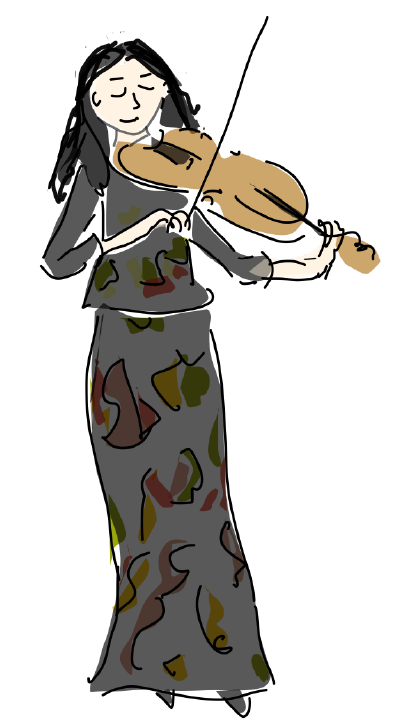 De laatste kandidate komt uit Spanje! Cristina Cordero. Programma Bach vierde suite en eens andere delen, Allemande en Bourree. Zij speelt de Chaconne van Arad met heel veel tijd. Laat het herkenbare thema iedere keer in alle rust terug komen. alles klinkt heel natuurlijk en organisch. In Hindemith 11/5 laat Cristina de drieklanken bijna allemaal tegelijk klinken. Jammer ze is er even uit. Ze is zo’n goede altvioliste! Zo mooi speelt ze.
De laatste kandidate komt uit Spanje! Cristina Cordero. Programma Bach vierde suite en eens andere delen, Allemande en Bourree. Zij speelt de Chaconne van Arad met heel veel tijd. Laat het herkenbare thema iedere keer in alle rust terug komen. alles klinkt heel natuurlijk en organisch. In Hindemith 11/5 laat Cristina de drieklanken bijna allemaal tegelijk klinken. Jammer ze is er even uit. Ze is zo’n goede altvioliste! Zo mooi speelt ze.
Om 17.30 komt het verlossende woord van de jury: De halve finale wordt gespeeld door
- Ionel Ungureanu
- Yuri Yoon
- Alona Khievna
- Carla Usberti
- Emiko Yuasa
- Njord Kårason Fossnes
Verslag van de halve en hele finales volgt in de volgende aflevering(en)!
